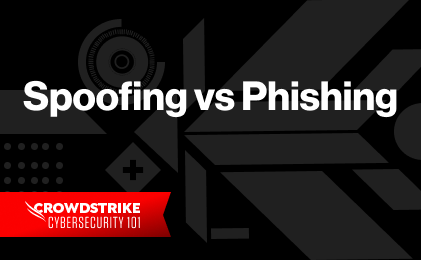March 14, 2023
Remaining vigilant against cybersecurity threats such as phishing and spoofing attacks is crucial — no one is immune. Phishing and spoofing attacks are similar, but they are two distinct cybersecurity threats. Understanding the difference between phishing and spoofing and the dangers they pose can boost your cybersecurity awareness and help you protect your business.
Spoofing attacks resemble identity theft while phishing attacks attempt to steal sensitive information. Notably, a phishing attempt may begin with a spoofing attack. Phishing, however, is never part of spoofing.
In spoofing attacks, threat actors disguise themselves as legitimate sources to gain the victim’s trust. The intention behind a spoofing attack is to install malware and orchestrate further crimes with the information or access gained. Spoofing attacks can take many forms, including the following:
A phishing attack is a scam in which a threat actor sends generic messages in mass quantities, usually via email, in hopes of getting anyone to click on malicious links. The intent is usually to steal credentials or personal information, such as your social security number. Four of the most common types of phishing attacks are outlined below.
It’s easy to see that spoofing attacks and phishing attacks are related yet distinct cybersecurity threats. Further examining the characteristics of each threat clarifies their differences.
One of the most effective ways to protect against phishing is to teach people how to spot an attempt and why they must report it to the right people. In this blog, learn about phishing threats and the best practices for tackling this persistent problem. Blog: Why Phishing Still Works (and What To Do About It)
The dangers of spoofing and phishing are vast. At minimum they’re inconvenient, and at their worst, they result in financial loss and other damage. Familiarizing yourself with the risks of spoofing and phishing is a critical step in taking these cybersecurity threats seriously.
Cyberattacks such as spoofing and phishing typically come with similar intentions, and they target a range of victims from individual users to corporations of all sizes or even governments. Both attacks aim to steal personal information or account credentials, extort money, install malware or simply cause disruptions. When targeting businesses or other organizations, the threat actor’s goal is usually to access sensitive and valuable company resources, such as intellectual property, customer data or payment details.
From a business perspective, securing your organization’s digital assets has the obvious benefit of a reduced risk of loss, theft or destruction. Additionally, it minimizes the likelihood of losing control of company systems or information — and having to pay a ransom to regain control. In preventing or quickly remediating cyberattacks, the organization also minimizes potential negative effects on business operations.
Some spoofing and phishing attacks are more dangerous than others. Outlandish attacks are easy to spot, but others are savvier. For example, spear-phishing attacks are especially dangerous and more likely to deceive potential victims due to their personal nature. Recognizing how phishing scams and spoofing work together can help you spot cybersecurity attacks that double down with complex techniques. Phishing attacks that include spoofing pose some of the most dangerous threats.
How to Prevent and Address Spoofing
Protecting yourself from spoofing attempts is integral to responsible online behavior. In many cases spoofing attacks are easy to detect and prevent through cybersecurity awareness. Follow these tips on what to do and what not to do to protect yourself from spoofing:
If you suspect you’ve received a spoofed email, verify the message’s validity by contacting the sender using another mode of communication; do not reply to the suspicious email. Remain aware of any further damage and take steps to secure your personal information.
Minimizing the risk of phishing attacks is crucial to your organization’s cybersecurity strategy. Conduct security awareness training with employees to ensure they know how to identify and report suspected phishing attacks. Below are a few simple strategies to help defend against the many types of phishing:
If you experience a phishing attack, don’t panic. Simply reading a phishing email is normally not a problem. Phishing attacks require the victim to click a malicious link or download files to activate the malicious activity. Monitor your accounts and personal information and remain vigilant.
It’s impossible to prevent phishing attacks, but you can exercise caution in engaging with electronic communication and encourage your employees to do the same. If you recognize a phishing email, you also can report it to the U.S. government at [email protected].
As cybercrime of all kinds, and phishing, in particular, reaches new heights, it’s important for every person in your organization to be able to identify a phishing attack and play an active role in keeping the business and your customers safe. Learn more! Learn: How to Implement Phishing Attack Awareness Training
Implementing a proactive protection strategy to shield yourself and your organization against cybersecurity attacks is essential. CrowdStrike’s expert team proactively hunts, investigates and advises on activity in your environment to ensure cyber threats are not missed.
Stay a step ahead of online adversaries by leveraging the latest digital technologies. The CrowdStrike Falcon® platform delivers cloud-native, next-generation endpoint protection via a single lightweight agent and offers an array of complementary prevention and detection methods. Learn more here.
Bart is Senior Product Marketing Manager of Threat Intelligence at CrowdStrike and holds +20 years of experience in threat monitoring, detection and intelligence. After starting his career as a network security operations analyst at a Belgian financial organization, Bart moved to the US East Coast to join multiple cybersecurity companies including 3Com/Tippingpoint, RSA Security, Symantec, McAfee, Venafi and FireEye-Mandiant, holding both product management, as well as product marketing roles.
Spoofing vs Phishing: Definition & Differences – CrowdStrike

